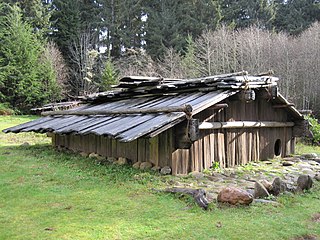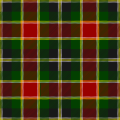
The Kwakwa̱ka̱ʼwakw, also known as the Kwakiutl are one of the indigenous peoples of the Pacific Northwest Coast. Their current population, according to a 2016 census, is 3,665. Most live in their traditional territory on northern Vancouver Island, nearby smaller islands including the Discovery Islands, and the adjacent British Columbia mainland. Some also live outside their homelands in urban areas such as Victoria and Vancouver. They are politically organized into 13 band governments.

A raincoat is a waterproof or water-resistant garment worn on the upper body to shield the wearer from rain. The term rain jacket is sometimes used to refer to raincoats with long sleeves that are waist-length. A rain jacket may be combined with a pair of rain pants to make a rainsuit. Rain clothing may also be in one piece, like a boilersuit. Raincoats, like rain ponchos, offer the wearer hands-free protection from the rain and elements; unlike the umbrella.

A basket is a container that is traditionally constructed from stiff fibers and can be made from a range of materials, including wood splints, runners, and cane. While most baskets are made from plant materials, other materials such as horsehair, baleen, or metal wire can be used. Baskets are generally woven by hand. Some baskets are fitted with a lid, while others are left open on top.

Callitropsis nootkatensis, formerly known as Cupressus nootkatensis is a species of trees in the cypress family native to the coastal regions of northwestern North America. This species goes by many common names including: Nootka cypress, yellow cypress, Alaska cypress, Nootka cedar, yellow cedar, Alaska cedar, and Alaska yellow cedar. The specific epithet "nootkatensis" is derived from its discovery by Europeans on the lands of a First Nation of Canada, those lands of the Nuu-chah-nulth people of Vancouver Island, British Columbia, who were formerly referred to as the Nootka.

Thuja plicata is an evergreen coniferous tree in the cypress family Cupressaceae, native to western North America. Its common name is western redcedar, and it is also called Pacific redcedar, giant arborvitae, western arborvitae, just cedar, giant cedar, or shinglewood. It is not a true cedar of the genus Cedrus.

A shawl is an Indian simple item of clothing, loosely worn over the shoulders, upper body and arms, and sometimes also over the head. It is usually a rectangular or square piece of cloth, which is often folded to make a triangle, but can also be triangular in shape. Other shapes include oblong shawls.

Indigenous peoples of the Northwest Plateau, also referred to by the phrase Indigenous peoples of the Plateau, and historically called the Plateau Indians are indigenous peoples of the Interior of British Columbia, Canada, and the non-coastal regions of the Northwestern United States.

The Sechelt or Shíshálh people, are an indigenous people of the Pacific Northwest Coast. At the time of the first European contact the Sechelt had a population of close to 26,000. Sechelt women were famous for their beautiful cedar woven baskets, which were made using materials such as cedar tree roots, cannery grass and birch bark.

Barkcloth or bark cloth is a versatile material that was once common in Asia, Africa, and the Pacific. Barkcloth comes primarily from trees of the family Moraceae, including Broussonetia papyrifera, Artocarpus altilis, Artocarpus tamaran, and Ficus natalensis. It is made by beating sodden strips of the fibrous inner bark of these trees into sheets, which are then finished into a variety of items. Many texts that mention "paper" clothing are actually referring to barkcloth.

Northwest Coast art is the term commonly applied to a style of art created primarily by artists from Tlingit, Haida, Heiltsuk, Nuxalk, Tsimshian, Kwakwaka'wakw, Nuu-chah-nulth and other First Nations and Native American tribes of the Northwest Coast of North America, from pre-European-contact times up to the present.

African textiles are textiles from various locations across the African continent. Across Africa, there are many distinctive styles, techniques, dyeing methods, and decorative and functional purposes. These textiles hold cultural significance and also have significance as historical documents of African design.

A plank house is a type of house constructed by indigenous peoples of the Pacific Northwest, typically using cedar planks.

The Andean textile tradition once spanned from the Pre-Columbian to the Colonial era throughout the western coast of South America, but was mainly concentrated in Peru. The arid desert conditions along the coast of Peru have allowed for the preservation of these dyed textiles, which can date to 6000 years old. Many of the surviving textile samples were from funerary bundles, however, these textiles also encompassed a variety of functions. These functions included the use of woven textiles for ceremonial clothing or cloth armor as well as knotted fibers for record-keeping. The textile arts were instrumental in political negotiations, and were used as diplomatic tools that were exchanged between groups. Textiles were also used to communicate wealth, social status, and regional affiliation with others. The cultural emphasis on the textile arts was often based on the believed spiritual and metaphysical qualities of the origins of materials used, as well as cosmological and symbolic messages within the visual appearance of the textiles. Traditionally, the thread used for textiles was spun from indigenous cotton plants, as well as alpaca and llama wool.

Alaska Native cultures are rich and diverse, and their art forms are representations of their history, skills, tradition, adaptation, and nearly twenty thousand years of continuous life in some of the most remote places on earth. These art forms are largely unseen and unknown outside the state of Alaska, due to distance from the art markets of the world.

Salish are skilled weavers and knitters of the Pacific Northwest. They are most noted for their beautiful twill blankets many of which are very old. The adoption of new fabrics, dyes, and weaving techniques allow us to study a wide variety of Salish weavings today.

Kwakwaka'wakw art describes the art of the Kwakwaka'wakw peoples of British Columbia. It encompasses a wide variety of woodcarving, sculpture, painting, weaving and dance. Kwakwaka'wakw arts are exemplified in totem poles, masks, wooden carvings, jewelry and woven blankets. Visual arts are defined by simplicity, realism, and artistic emphasis. Dances are observed in the many rituals and ceremonies in Kwakwaka'wakw culture. Much of what is known about Kwakwaka'wakw art comes from oral history, archeological finds in the 19th century, inherited objects, and devoted artists educated in Kwakwaka'wakw traditions.

Textile arts of indigenous peoples of the Americas are decorative, utilitarian, ceremonial, or conceptual artworks made from plant, animal, or synthetic fibers by native peoples of both North and South America.

Yellow cedar is a culturally, economically and environmentally significant species to the Pacific Northwest and was used extensively by indigenous peoples throughout the region.

Lisa Telford is a Git'ans Git'anee Haida weaver who creates contemporary garments, shoes and other objects using Northwest Coast style weaving techniques. Her work serves as a commentary on Native identity, stereotypes and fashion.

Douglas Reynolds Gallery is an art gallery in Vancouver, British Columbia. It is located in the Business Improvement Area of South Granville. The gallery was founded in 1995 by Douglas Reynolds.






















